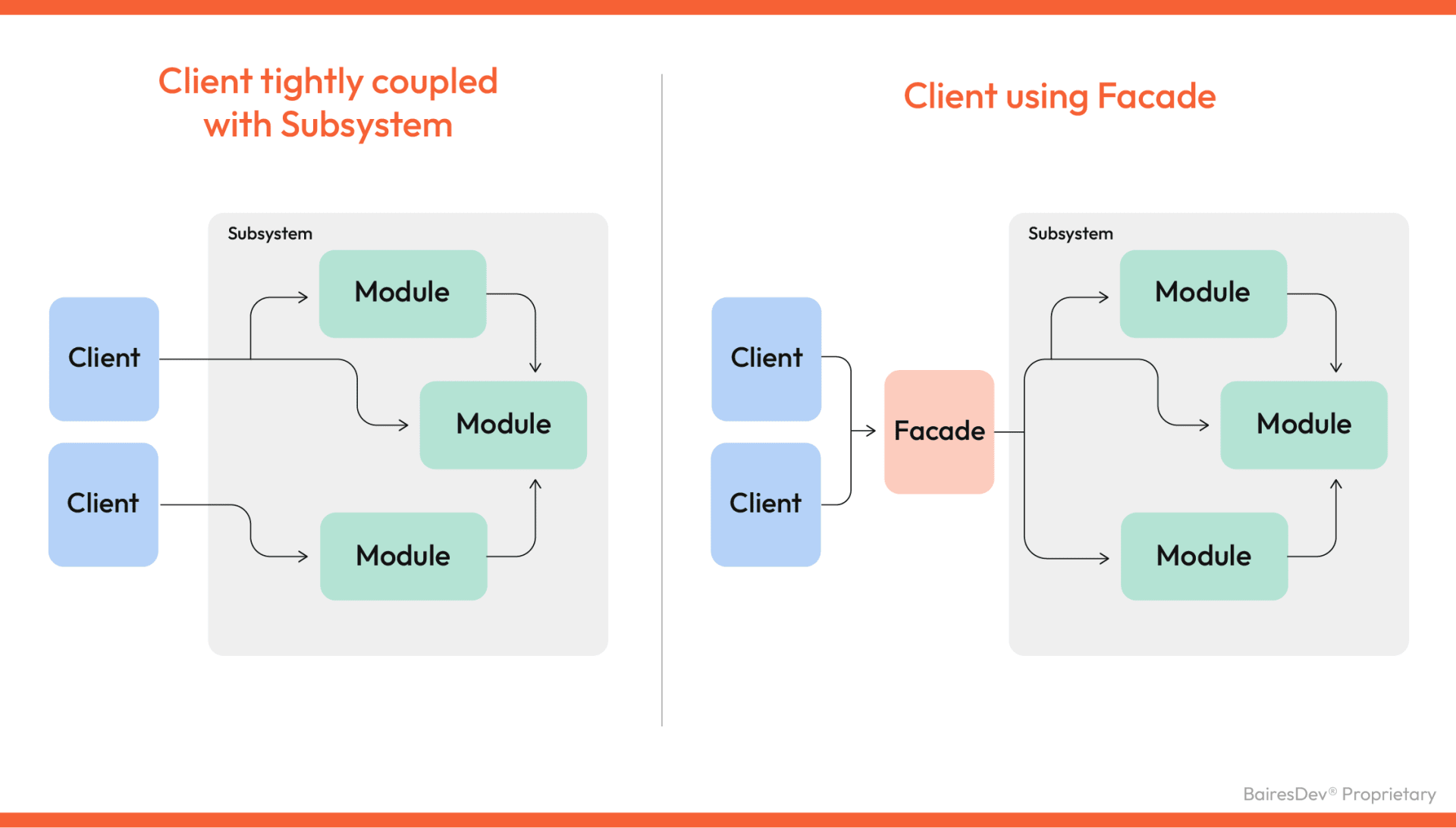Tired of tangled spaghetti code giving you headaches? Struggling with complex software that’s confusing to work with and tough to maintain? Then let’s talk facades—no, not the front of buildings, but facade design patterns in Java.
Understanding Java data structures is essential when implementing facade patterns effectively, as they help manage underlying complexity while maintaining a clean interface.
Facade patterns provide a simple, easy-to-understand interface that hides the messy complexity of the underlying system. Think of them like a valet at a fancy restaurant, presenting you with just the essentials while all the complicated work happens seamlessly behind the scenes.
In this article, we’ll explore why Facade patterns are so useful, how to implement Facades in Java, and examples of Facades in action across frameworks like Spring and Java I/O. You’ll learn best practices for crafting elegant Facade interfaces along with handy tips for working with Facades without losing flexibility.
So say goodbye to tangled code and welcome clean, simplified design with Java Facade patterns! We’ll have that spaghetti untied and laid out neatly in no time. Read on to get started bringing order to your unruly codebase.
What Are Software Design Patterns?
Software design patterns are like blueprints for solving commonly occurring problems in software design. They represent the best practices developed by experienced Java software developers and provide a structure that can help us write code that is easier to understand, maintain, and scale.
A design pattern is not a finished design that can be transformed directly into code. It is a description or template for how to solve a problem that can be used in many different situations.
Some design patterns even support efficient handling of Java concurrency, allowing developers to manage multi-threaded operations with ease and safety.
Importance of Design Patterns
Design patterns are reusable solutions to common problems that arise in software development. They provide a proven, standardized approach to solving specific design problems, making it easier for developers to create robust, maintainable, and scalable software systems.
Solutions to Recurring Problems
One of the primary benefits of design patterns is that they offer solutions to recurring problems. By using a design pattern, you can avoid reinventing the wheel and save time and effort in finding a solution that works.
Higher Readability and More Efficient Solutions
Design patterns also promote higher readability and more efficient solutions. By following a standardized pattern, developers can create code that is easier to understand and maintain. This is especially important in Java development, where code readability is critical for maintaining large-scale applications.
Moreover, design patterns help ensure that the code is more efficient, as they have been tried and tested over time. By using a proven pattern, developers can avoid common pitfalls and mistakes, leading to faster development and better overall performance.
Improved Collaboration and Communication
Design patterns also facilitate improved collaboration and communication among developers. By using a shared vocabulary and set of patterns, developers can communicate more effectively and work together more efficiently. This helps ensure that everyone involved in the project is on the same page, which is essential for delivering high-quality software solutions.
In summary, design patterns are essential for Java software development, as they provide a proven, standardized approach to solving common problems. By using design patterns, developers can create more robust, maintainable, and scalable software systems while also improving collaboration and communication among team members.
Types
Design patterns are of many types including low level design patterns that are specific to the language in which it is implemented to high level patterns which can be implemented in any language.
In object-oriented programming, common design patterns are broadly classified into creational, structural, and behavioral patterns.
Creational Pattern
Creational patterns provide mechanisms for creating or reusing classes and objects. There are five creational patterns:
- Abstract Factory
- Builder
- Factory Method
- Prototype
- Singleton.
First, they all encapsulate knowledge about which concrete classes the system uses. Second, they hide how instances of these classes are created and put together. All the system at large knows about the objects is their interfaces as defined by abstract classes. Consequently, the creational patterns give you a lot of flexibility in what gets created, who creates it, how it gets created, and when.
They let you configure a system with “product” objects that vary widely in structure and functionality. Configuration can be static (that is, specified at compile-time) or dynamic (at run-time).
Structural Pattern
Structural design patterns are concerned with assembling objects and classes into larger structures while keeping these structures flexible and efficient. This pattern is particularly useful for making independently developed class libraries work together. Some common structural design patterns are decorator, adapter, and builder.
Behavioral Pattern
Behavioral patterns are concerned with algorithms and the assignment of responsibilities between objects. They describe how objects communicate with each other. Some frequently used behavioral patterns include Observer, Iterator, State, and Mediator.
Facade pattern
The facade design pattern is used to simplify the interaction between clients and subsystems.
A facade object provides a simple interface to a set of interfaces of a complex subsystem, making it easier to use.
Example – Audio Player
Let’s imagine a simple audio system. First, we have a MediaSource class that returns information about all the media sources present. When getAudioSource() is invoked, we get the audio source for playing our audio. The Path.exists() function which checks if a given path is valid or not. The AudioDecoder decodes an audio file and provides an Audio object that can be played.
All these methods and classes are hypothetical, but this is how a typical audio-playing service would look like.
class Audio {}
class AudioSource {
void play(Audio audio) {}
void pause() {}
void resume() {}
}
class MediaSource {
static AudioSource getAudioSources() {}
}
class Path {
static boolean exists(String pathname) {}
}
class AudioDecoder {
Audio decode(String fileName) {}
}
Using these modules directly can make our code complicated and prone to errors. Hence, it’s better to create a facade class that interacts with these modules and we use the facade class. These constructs are quite common. You may have implemented a facade without knowing about it.
class AudioPlayer {
AudioDecoder decoder;
AudioSource source;
AudioPlayer() {
this.source = MediaSource.getAudioSource();
this.decoder = new AudioDecoder();
}
Use Cases
In this section, we will look at scenarios where you might consider using the facade design pattern.
Simple Interface to a Complex Subsystem
Imagine you’re working on a module with multiple classes offering different functionalities, and you only want a subset of those functionalities. Consuming it directly can make your code get coupled together, making it hard to debug. The facade object, you can only expose the functionality you need, making your code easier to manage.
Decoupling Dependencies Between Clients and Subsystem Classes
As codebases become more and more complex, their classes become more tightly coupled together. It becomes harder to maintain and easy to introduce bugs in it. The facade pattern can be used to decouple the subsystem from the clients.

Create a Single Entry Point
Use it when you want a single entry point into your subsystem. In the example of the audio player, we had a few modules for working with audio. If we use these modules in multiple places in our codebase, it will become difficult for us to introduce new functionality in our audio player. This problem can be solved by using a facade class. Every time we need to make changes to the behavior of our audio player, we only have to change the facade class.
Conclusion
The facade is a typical design pattern that simplifies interaction between two systems. Working in any Java IDE, you can use this design pattern to refactor your code whenever it gets too interconnected or complex. It’s a popular approach in Java development services, especially when aiming to streamline codebases and improve maintainability. For companies seeking efficiency at scale, outsourced Java development can be a smart way to implement such patterns effectively.
FAQ
What are some examples of facade software design patterns?
- The JDBC interface in Java, which provides a uniform way of accessing different types of databases, without exposing the details of each driver implementation.
- JavaServer Faces (JSF): JSF is a framework for building component-based user interfaces for web applications in Java. It provides a facade for the underlying technologies such as servlets, JSPs, and HTML rendering.
- Java Message Service (JMS): JMS is an API for sending messages between two or more clients. It provides a facade for the underlying messaging system by hiding the details of the message format and transport protocol.
What is the difference between the facade and the adapter pattern?
The facade pattern simplifies interaction with complex systems, including intricate data structures, by providing a streamlined interface that hides underlying complexity. Conversely, the adapter pattern allows the integration of disparate data structures by converting one class interface to another, enabling compatibility between different system components.






